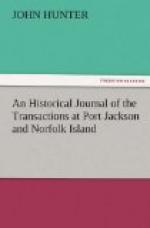On our first landing, we found a great number of pigeons, which were so tame, that we knocked them down with sticks; but latterly they quitted the low boughs, and generally harboured about the tops of the pines: when plucked and drawn, they weighed from three-quarters, to one pound each. The parrots are numerous, and the ugliest bird of the kind I ever heard of; this, added to the harshness of their note, makes them a very disagreeable bird. The parroquets are entirely green, except a red tuft on their head. Hawks are numerous and of two different kinds, the grey and blue: they were great enemies to the young chickens, and it was no unusual sight to see them take up the rats. Quails and curlews are plentiful, but very shy. The owls, which have very handsome plumage, make a noise like one man calling to another, and they pronounce the word “yaho” very distinctly. Many of the smaller birds have a most melodious note, and their plumage is very beautiful.
There are also a species of birds which burrow in the ground like rabbits, where they hatch their eggs, and rear their young: they are web-footed; which is rather extraordinary, and their bill is like that of other sea-fowl; but they have not the least fishy taste, and their flesh is very fine. These birds never quit their holes till sun-set; from which time, until midnight, the air is full of them: they afforded us many fresh meals.
I now set the two sawyers and two carpenters to work in building houses; one man was employed in making a crab to heave the boat by, another attended the live-stock, and the remainder were busied in clearing ground at Mount George, and Arthur’s Vale.
By the 17th, the rain was almost incessant, and, as I had every reason to suppose it would continue so three or four months longer, which would endanger the health of those who lived in tents; I caused the provisions to be removed from the store-house to a cellar under my house, which was dry, and the stores I put into a loft; and, as five men and three women lived at present in tents, I put them into the store-house, until they could build huts for themselves. The whole settlement were now well sheltered, except the surgeon and the midshipman; for whom I proposed to begin a house immediately.
On the 18th, the shell of my house was finished: its dimensions were twenty-four feet long by twelve feet wide, and eight feet under the eaves: the sides and roof were weather-boarded.
I sent the boat out this afternoon, and she returned with fifty very fine fish, which were issued out as usual.
I set out on the 19th, with an intention of tracing the rivulet which runs through Arthur’s Vale, to its source, and likewise to examine the extent of the valley; but, after wandering about the greatest part of the day, I returned back, much fatigued, and all the cloaths torn off my back by the briars and the entangled state of the woods.
Arthur’s Vale is situated between the north side of Mount George and the opposite hills: its direction is about north-north-west into the interior part of the island. The bottom of this valley, in some places, is not more than thirty yards wide; in others, at least three hundred. The hills on each side are cloathed with a thick forest; their ascent is not too steep for cultivation, and the soil is excellent, being a fat brown earth.




